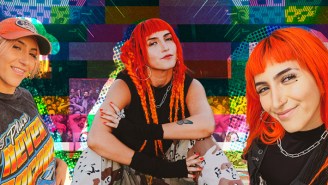Uproxx knows that science, technology, engineering, and math (STEM) disciplines are driving the future of this planet forward. Every day, we see new ideas, fresh innovations, and bold trailblazers in these fields. Follow us this month as we highlight how STEM is shaping the culture of NOW.
Helena Price always loved photography. Even when she was working a traditional job in Silicon Valley, she couldn’t help but remember how happy taking pictures made her as a child. “I’ve been shooting since I was six,” she says. “My Dad was really into just those little cameras from Walmart, so I got really into those little cameras from Walmart. I just shot everything, like my stuffed animals or my cats and dogs.”
Years later, when Price realized that she wasn’t happy in her tech job, she decided to return to her childhood dream. “I rediscovered photography and just became obsessed with it again,” she says. “I had a hunch that it was the right time to try and make a business out of it and it totally worked.”
Price made a name for herself in Silicon Valley doing corporate portraits and photographing the tech world. But as much as she loved that work, Price felt a calling to showcase other voices in the industry. People who weren’t normally the high profile faces of bluechip companies (read: straight, white men).
“I just wanted to find people who came from really non-traditional backgrounds, different than what you’d expect from Silicon Valley,” she says. “It was really hard for them to get here. They went through a ton to get to where they are, but they also love their work. Even though it’s been hard, they want to stay because they love tech and they want to see the industry get better.”
I talked to Price about her project showcasing minority voices in the tech industry, and a more recent offshoot highlighting immigrants in tech. Her photos and detailed oral histories reveal a side of the industry that is too often ignored.
Silicon Valley may still have a long way to go when it comes to diversity, but there are women, people of color, and LGBTQ folks rocking the industry, breaking the glass ceiling, and paving the way for newcomers. Price brings their stories to light so that a new generation of STEM (science, technology, engineering, math) students will be inspired to join them.
You’ve recently branched out from your normal commercial and portraiture work to do oral histories and bigger projects. What inspired you to do that?
I’ve been obsessed with oral histories for a really long time and for over a decade now I’ve been wanting to do projects that combined photos and oral histories. I was into the idea of libraries of stories, how they can function as art, but also how they can help people learn from a big collection of human experience. I just hadn’t done it because I didn’t feel like I had the time or the resources. Last year was really the first year where I was like, “Ok, I think I can take some time off. I have a little bit of money in my savings account and I’m gonna do it.”
At the time it just clicked that I should do it on Silicon Valley.
How did you come across your subjects?
I put a call for subjects out on Twitter. I was like, I hope a hundred people see this. And it just spread. I think the industry was really ready for something like this to come along, their opportunity for ordinary people to tell their stories. It just spread, and spread, and spread, and spread. Within two weeks I had five hundred amazing applications.
How do you pick people from that then? What was your process?
Oh my god, it took a long time. So, I think it took over a hundred hours of reading. I asked people a series of questions in the application like: “Tell me a bit about how you got to Silicon Valley?”; “Tell me about some of your proudest moments working in tech?”; “Tell me about some of your biggest challenges?”
I would read through all of them and whittle it down. And the first time I whittled it down I think I got it to 273. And then I whittled it down again to 150, and again to 120. It’s hard. I didn’t want to fill quotas. I wanted to find 100 stories that all felt like they touched on a different challenge so that as many people as possible would have something to relate to.
Were there one or two that really struck you from that initial application as incredible stories?
They’re all so good! And people’s applications are one thing but when you sit down with them for an hour and interview them, then it can really blow your mind. The first that comes to mind is Nancy Douyon, now she’s a spokesperson at Google, and she just had a crazy upbringing. Growing up in a community of immigrants, tons of poverty, she ended up responding to a random magazine ad in the back of a magazine when she was 11. The magazine said, Do you have questions? And she was like “I do have questions”, so she walked into this magazine headquarters! They ended up taking her in with her parents’ permission and really mentoring her. She came from tons of poverty and a not so great family situation and is just killing it.
It’s amazing just seeing the kind of drive and resilience that so many of the people have in this project.
For your subjects, were there a lot of stories of discrimination and not being respected in their field because they were different?
Oh for sure. I think most people who relate to any minority community or are women have experienced something like that. For some people, it effected them really profoundly. But I think it also affected them in other more minor ways like when people just don’t see a version of themselves to look up to. It’s so common that I think a lot of us in the industry have just kind of learned to live with it, but I think people are really starting to be open to talking about it and addressing it.
Did you find yourself really personally and emotionally affected by the stories in these interviews?
It’s the hardest and heaviest work I’ve ever done in my life. On the production side alone, I put over 1,000 hours into the project in just three months, so I was working 18 hour days every day with no days off. So that alone wasn’t awesome, but then you add on the emotional part of it and you’re internalizing 100 really intense stories. I’m an empath so I soak it all in and I take it on my back. Then, there’s also the responsibility of presenting these stories in a way that do justice to the subject. Just the responsibility I carry to not only do these subjects justice but also brace myself for carrying the brunt of whatever reaction the project gets.
It’s the heaviest thing ever, but I had to just ask myself is it worth it, and to me it was.
What has the response been?
Well, it’s a full range. You do any sort of project that has an opinion or some sort of political angle to it and you’re going to have people who love it and you’re going to have who think you’re the devil. The project had a ton of positive impact, which was really awesome. Like Nancy got the spokesperson position at Google because Google was like “This is the kind of thing that we want to celebrate.” So it’s been really cool to see those kinds of things happen and all the opportunities that have come to people in this project.
And then on the flip side there are people that are angry for any reason you can think of. You’ve got people who think that I made up the whole thing and that these issues don’t exist. And then you’ve got people that are really mad that a white woman is getting attention for creating a diversity project. It’s totally valid.
I imagine with your most recent project, “Banned”, that there was a lot of that. What made you decide to do a project specifically about immigrants in tech?
I think all of us in this political climate are sitting here feeling really helpless, like what can I do? I’m a big believer that we all have our own talents that we can apply to contribute in really unique ways. For me, it was taking pictures and doing interviews.
It was just a moment where it was like “man, this makes me so mad.” Within a few hours I was like “Okay, I better do a photo project”.
Did you see commonalities in the subjects you interviewed about their fears of this administration?
It was such a small group that there was actually quite a bit of variety between the stories. I think a lot of people who don’t know any better just put everybody in a bucket. And they think that everybody potentially affected by this legislation is one kind of person, and god knows what kind of person they think that is.
This project even opened my eyes to the variety of ways in which people could be affected by this legislation. Everything from the visa issue to people being scared to lose their own families in America if they go try to travel and visit their extended families. It’s really complicated. A big thing that I wanted to convey was that it’s not even about what’s written firmly in the legislation, it’s the fear. Like being scared that they can’t go to London for a business meeting because they might not be able to come back.
People assume that immigrants are just criminals and for me it was like, I want to really give the extremist viewer the opportunity to hear these peoples voices, see how they move, and see how they’re just normal people who are really nice and who you might be friends with. It’s just important for so many people in America to understand that these are just normal people. They lead very similar lives.
Michelle Morrison
Chanpory Rith






